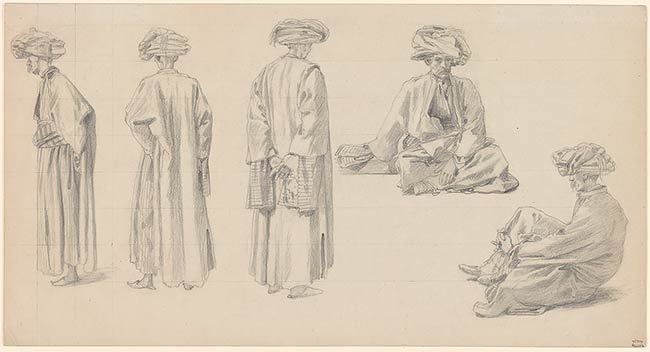
Dauzats traveled to Egypt, Syria, Palestine, and Turkey in 1830 and ventured to French-occupied Algeria in 1839. Drawings made during these trips supplied him with content for his Salon paintings as well as for lithographic and engraved illustrations, such as the plates for his patron Baron Isidore Taylor's series of volumes, including the "Voyage pittoresque en Espagne, en Portugal, et sur la cote d'Afrique, de Tanger a Tetouan" (1826-32), and "Voyage pittoresque en Syrie, l'Egypte, la Palestine et la Judee" (1835-39).
The five studies on this sheet reflect sustained observation suggesting the sitter posed for Dauzats. He depicted the man standing and seen from three different angles and seated in two poses, one frontal, the other in profile. Dauzats drew horizontal lines across the entire sheet, but they intersect with vertical lines only in the leftmost figure. This partial squaring suggests that only the standing figure in profile to the right was used in a painting that has yet to be identified.
The man is elegantly dressed in an entari, or long striped silk garment, underneath a djubba, or outer robe, with a wide waistband over his entari and babouche, or heelless slippers, on his feet. This type of dress was worn by well-to-do merchants throughout North Africa, the Middle East, and Turkey, and is characteristic of Christian as well as Jewish costume from the period. His lack of a beard, full moustache, and full turban suggest he may be an Ottoman Turk. The distinctive turban he wears is strikingly similar to that worn by the artist himself in a portrait by Claude Marie Dubufe, commonly known through Loys Delteil's reproduction in an 1896 edition of "L'Artiste."
Another sheet containing three studies of the same man is in the Musée Magnin in Dijon (1938 DF 226). Dauzats depicted him leaning forward with his hands on his thighs, praying, and seen from the front and behind. The artist added light washes of blue and rose to the costume. The museum notes that Dauzats may have made the study in connection with his trip to the ancient port city of Jaffa in 1830. That year, Dauzats had left for Egypt with Baron Taylor to purchase an obelisk in Luxor, and their journey continued to Syria and Palestine during July and August.
Black ink stamp at lower right, "Vente / Dauzats"; inscribed on verso, in graphite, sideways near center, "369".
Watermark: none
Thayer, John M. (John MacLane), 1944-2004, former owner.
